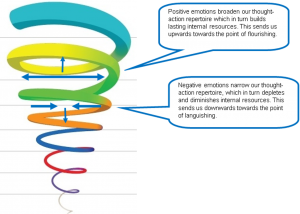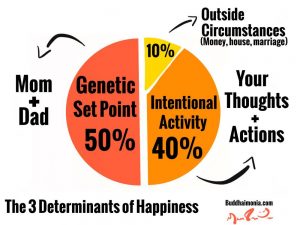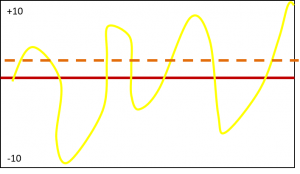[vc_row][vc_column][vc_column_text]Barbara Fredrickson posited the question “Why is happiness important?” and over the course of her research she’s answered it with her simple Broaden and Build theory. The theory proposes that as we experience positive emotions we become open to a broader range of thoughts and a broader range of actions. (Termed our ‘thought action repertoire.’) Then, as we feel and think more positively, we act in a more positive way. The result of which is that our internal resources (Social, Intellectual, Physical and Psychological) increase, again providing more positive emotions, and continuing the upward spiral effect.[/vc_column_text][vc_column_text] Interestingly, Fredrickson also found that to create this upward spiral of positivity you need a ratio of 3 positive emotions to every 1 negative emotion. Effectively having a 3:1 positivity ratio is ideal to reach the point of flourishing.[/vc_column_text][vc_column_text]It’s important to acknowledge negative emotions play a key role in both achieving flourishing and developing perspective.[/vc_column_text][vc_column_text]
Interestingly, Fredrickson also found that to create this upward spiral of positivity you need a ratio of 3 positive emotions to every 1 negative emotion. Effectively having a 3:1 positivity ratio is ideal to reach the point of flourishing.[/vc_column_text][vc_column_text]It’s important to acknowledge negative emotions play a key role in both achieving flourishing and developing perspective.[/vc_column_text][vc_column_text]
The Happiness Pie
 [/vc_column_text][vc_column_text]Sonja Lyubomirsky developed the Happiness Pie to describe where our happiness comes from, in comparison to the happiness of others. She found 50% is genetically set, this gives us a starting point in the game of happiness. Outside circumstances contribute to 10% and is often the things we work so hard to change. A whopping 40% is made up of our intentional activities. The key here word is intentional. When we consciously and mindfully become more positive in our thoughts and actions our happiness and subjective wellbeing increase substantially. [/vc_column_text][vc_column_text]Let’s assume our mental health exists on a scale of -10 (languishing) to +10 (flourishing.) Our genetic set point (assuming we are at 0) is indicated by the red line below. It’s simply a happiness set point, or starting point or average benchmark of our happiness and wellbeing levels set by our parents. The yellow line indicates our fluctuating circumstances and emotions. Some days are great, some days are terrible, think of it as the natural and inevitable ups and downs of life. [/vc_column_text][vc_column_text]
[/vc_column_text][vc_column_text]Sonja Lyubomirsky developed the Happiness Pie to describe where our happiness comes from, in comparison to the happiness of others. She found 50% is genetically set, this gives us a starting point in the game of happiness. Outside circumstances contribute to 10% and is often the things we work so hard to change. A whopping 40% is made up of our intentional activities. The key here word is intentional. When we consciously and mindfully become more positive in our thoughts and actions our happiness and subjective wellbeing increase substantially. [/vc_column_text][vc_column_text]Let’s assume our mental health exists on a scale of -10 (languishing) to +10 (flourishing.) Our genetic set point (assuming we are at 0) is indicated by the red line below. It’s simply a happiness set point, or starting point or average benchmark of our happiness and wellbeing levels set by our parents. The yellow line indicates our fluctuating circumstances and emotions. Some days are great, some days are terrible, think of it as the natural and inevitable ups and downs of life. [/vc_column_text][vc_column_text] The orange line represents the 40%, it’s our ability to redirect our thoughts and activities to lastingly improve our baseline of happiness. Our intention in positive psychology is that we not only experience more positive emotions, for longer, we also experience less negative emotions, and become more resilient to them. [/vc_column_text][vc_column_text]Essentially our objective in positive psychology is to focus on the 40% and develop habits that continually improve our base level of happiness.[/vc_column_text][vc_column_text]
The orange line represents the 40%, it’s our ability to redirect our thoughts and activities to lastingly improve our baseline of happiness. Our intention in positive psychology is that we not only experience more positive emotions, for longer, we also experience less negative emotions, and become more resilient to them. [/vc_column_text][vc_column_text]Essentially our objective in positive psychology is to focus on the 40% and develop habits that continually improve our base level of happiness.[/vc_column_text][vc_column_text]
[/vc_column_text][/vc_column][/vc_row]





